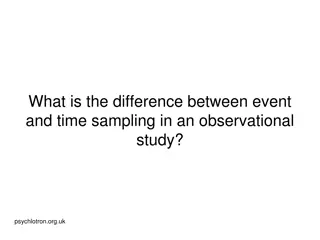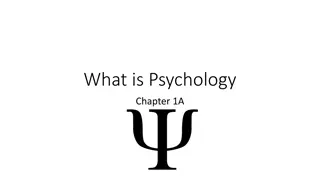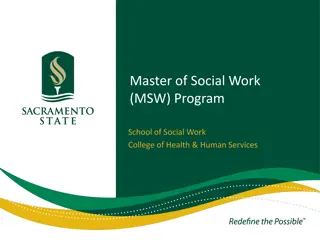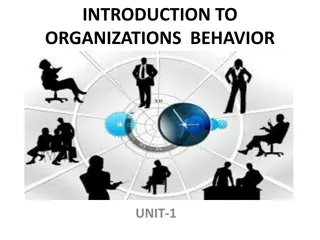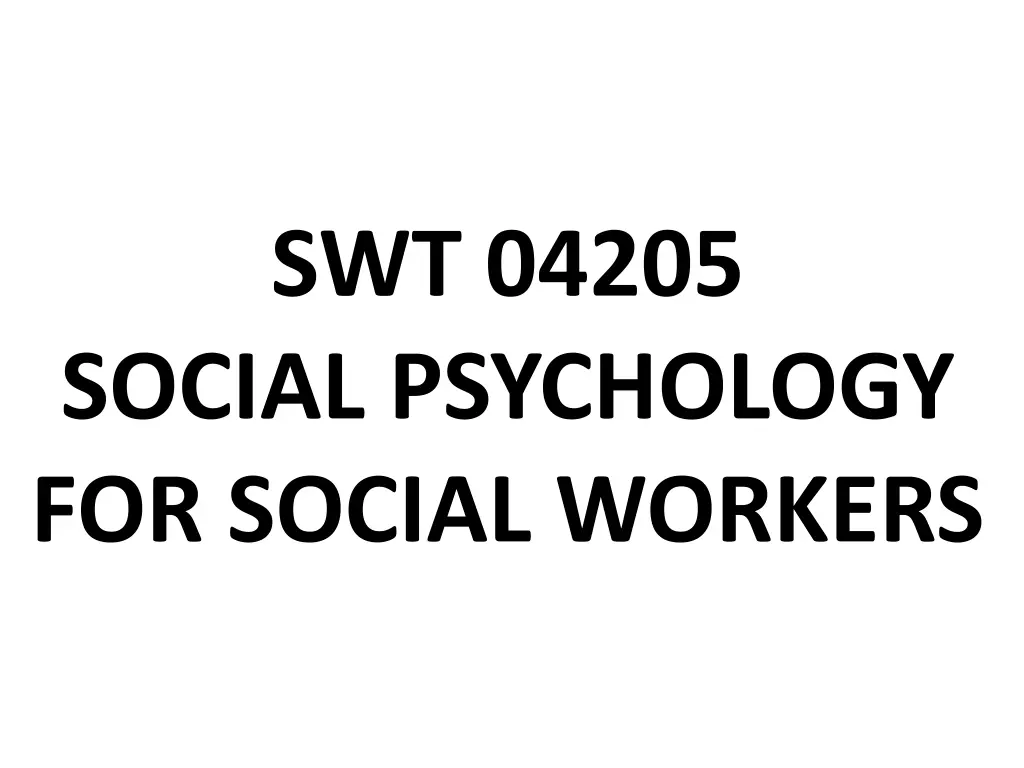
Understanding Social Psychology and Client Needs in Social Work
Explore the application of social psychology in identifying clients' needs, including the Maslow Hierarchy of Needs. Learn how social psychology influences and is influenced by others, helping social workers address physiological, safety, belongingness, esteem, and self-actualization needs to support client well-being.
Uploaded on | 1 Views
Download Presentation

Please find below an Image/Link to download the presentation.
The content on the website is provided AS IS for your information and personal use only. It may not be sold, licensed, or shared on other websites without obtaining consent from the author. If you encounter any issues during the download, it is possible that the publisher has removed the file from their server.
You are allowed to download the files provided on this website for personal or commercial use, subject to the condition that they are used lawfully. All files are the property of their respective owners.
The content on the website is provided AS IS for your information and personal use only. It may not be sold, licensed, or shared on other websites without obtaining consent from the author.
E N D
Presentation Transcript
SWT 04205 SOCIAL PSYCHOLOGY FOR SOCIAL WORKERS
Topic 1: Application of social psychology to identify the clients needs
Learning Tasks: By the end of the topic learners are expected to; Define the term social psychology as related to clients needs Describe the Maslow Hierarchy of needs. Describe physiological needs to identify clients needs (food, water, rest)
Cont Identify safety needs to identify client s needs (security and safety) Demonstrate belongingness and love to identify client s needs (intimate relationship and friends)
Cont Demonstrate esteem needs to identify client s needs Demonstrate self actualization needs to identify clients needs
Definition of the term Social Psychology as related to client s needs
Activity: Buzzing Buzz on the following questions Define: Social psychology ,client s needs
Social psychology Is the branch of psychology. It is a scientific study of how people's thoughts, feelings, and behaviors are influenced by the actual, imagined, or implied presence of others. It involves understanding how people influence, and are influenced by, the others around them.
Clients needs: need is something necessary for an organism to live a healthy life. It can be objective or physical needs such as the need for food, or psychological or subjective needs such belongingness. A that is as love and
Maslow Hierarchy of needs Maslow s hierarchy has indentified five levels of human needs. It is intended to track growth and development in human beings, beginning with infants, who aim to have only their most basic needs met. Typically, people reach different stages throughout life, of the hierarchy
Cont.. and at different times they might experience a deficit in a certain stage. When this occurs, a person will often temporarily abandon pursuit of a higher stage in order to have the more fundamental needs met.
Cont However, not all adult humans reach the top of the hierarchy, and poverty, illness, and other factors can interfere with a person s development Maslow s hierarchy. in
Activity: Small group discussion Discuss physiological needs (food, clothing, shelter)
Physiological needs as related to clients needs Physiological needs maintenance of the human body. The lowest category includes the most basic needs that are important to survival, such as the need for water, air, food, and sleep. Maslow believed that these needs are the most instinctive needs because all needs become secondary until these needs are met. deal with the
Cont there which However, factors achievement of physiological needs such as poverty, illness and other factors. are can some hinder
Safety and security These needs include personal security (absence of physical threat), financial security (absence of financial hardship), health and wellbeing (absence of illness or infirmity), and a safety net against accidents and illness and their adverse impacts (ability to receive appropriate medical care).
Activity: Small group discussion Into small groups discuss safety needs (health, security, e.t.c) Discuss from experience the concept of safety and security needs. personal and your own
Cont List health/ car insurance you know. Show its importance
Cont Safety always means protection. For example we purchase insurances, such as health and car, to protect ourselves from something unexpected occur. We do these things to increase our sense of safety and security and make us feel more comfortable in our lives.
Love and belongingness Need for love and belongingness includes the needs companions and supportive family, intimate relationship identification with a group. These needs are basing on affectionate and love. Everyone needs to be loved and love others. to friends, and
Activity: Role Play Scenario: A 15 years boy has been expelled from his family because he has failed the form two examinations. The family does not trust him, the society is afraid of him; the church/mosque is lesser caring of him. Now the boy does not belong to anywhere. Because of that isolation the boy has created delinquency behaviours.
cont One learner demonstrate as a boy, one as a parent, one as the community member and one as the religious leader The rest watch the role- play and make observation
Cont Esteem needs has been classified into two categories: (i) esteem for oneself (dignity, achievement, mastery, independence) and (ii) the desire for reputation or respect from others (e.g. status, prestige). A high level of Self-esteem can make empowered and perhaps, even improve your social relationships. a person feel
Self Actualization in relation to clients Self actualization is the final stage in the linear growth of an individual. Maslow believed that in order to achieve this state of personal fulfillment, the person must first satisfy the preceding needs (physiological, love/belongingness and esteem needs) safety,
Activity: Brainstorming Brainstorm on the concept of Self actualization in relation to clients needs What is the impact of self actualization to the clients needs
Cont actualization personal potential, seeking personal growth and peak experiences by reaching the end of the goal. This must be achieved once one s physiological, safety, love, and esteem needs are taken care of one can start thinking about self actualization. Self includes realizing self-fulfilment,
Key Points Learners should Maslow Hierarchy can facilitate the needs of the client. Some of the client s needs may be hierarchy of needs. Clients needs are interrelated therefore missing one need may lead to clients challenges. understand how rooted from this needs or
Evaluation What is love and belongingness What is esteem needs What is self actualization Relate the importance of love and belongingness, self actualization and self actualization in relation to client s needs.
REFERENCES Baron R.A,. (2008).Social Education, Psychology, Pearson USA Berk, L. E,. (2000). Child Development (5th ed.) United America: A Pearson Company. States Education of
Cont.. (2005). Corey, G,. Theory and Practice of Counseling and Psychotherapy (7th ed.). United States of America: Learning, Inc. Myers, D., & Spencer. S,. (2001). Social psychology. McGraw-Hill Ryerso Thomson Toronto:
End of topic 1 Question/ comments
Topic 2: Psychosocial Support To Determine The Needs Of The Client
Learning tasks By the end of the topic learners are expected to: Define the term psychosocial support Describe the concepts psychosocial support Identify types of psychosocial support (needs) for clients Explain mental education, related to health counseling,
Cont.. Explain spiritual support and group support, Explain sport and gamest Provide counseling determine needs of the client Provide education client s needs service to which inform
Definition of the term psychosocial support The psychosocial refers to the process of facilitating resilience within individuals, families and communities. It is the actions that address psychological and social needs of individuals. both the
Cont Psychosocial support addresses both the internal emotional factors, and the social factors that impact addresses factors that influence how they feel about themselves, how they feel about life, and what their expectations for the future are. psychological or people. It
Psychosocial support in the process of meeting a person's needs
Concepts Related To Psychosocial Support
Activity: Group Discussion Into small groups discuss on the following questions : 1. What is Psychosocial development 2. What is Psychosocial support 3. What is Psychosocial Wellbeing
Psychosocial development- It is much concerned on how social interaction relationships played a role in the development and human beings. Also, a sense of competence motivates behaviors and actions. and growth of
Psychosocial support Resilience within individuals, families and communities. It also refers to the actions that address psychological needs of individuals. both and the social
Emotional Resilience- It refers to one's ability to adapt to stressful situations or crises.
Psychological well-being It relationships personal mastery, autonomy, a feeling of meaning in life, and personal growth and development. consists of positive others, with purpose and
Types of psychosocial support (needs) for clients Mental health counseling Spiritual support Group support-
a) Mental health counseling Is a distinct profession with national standards for education, training, and clinical practice. Clinical mental health counselors operate from a wellness perspective, which emphasizes moving toward optimal human functioning in mind, body, and spirit, and away from distress, dysfunction, and mental illness.
b) Spiritual support- It helps to find value, meaning, trust, and strength difficult times. You and your family can connect with spiritual support during treatment, after treatment, or at end-of-life. during diagnosis,
c) Group support- In provide each other with various types of nonprofessional and nonmaterial, for a particular shared, usually burdensome, characteristic. group support members help, usually
Cont Members with the same issues can come together for sharing coping strategies, to feel more empowered and for a sense of community.
Cont Group support seeks to give clients a safe and comfortable campus where they can work out problems and emotional concerns. Members gain insight into their own thoughts and behavior, and offer suggestions and support to others. place on









